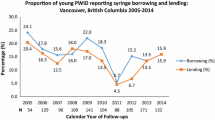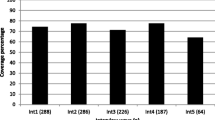Abstract
Syringe-exchange programs (SEPs) in Connecticut operate with caps on the number of syringes exchanged per visit. We investigated the effects of legislation increasing the cap on drug injectors' access to clean syringes through the SEPs in New Haven and Hartford. The mixed design of this study included longitudinal and crosssectional data from individuals and ecological data from program operations. Five parameters—syringe return rate, syringes per visit to the SEP, syringe reuse rate, syringe human immunodeficiency virus (HIV) prevalence, and syringe sharing—were monitored through syringe tracking and testing of SEP syringes and by interviewing injectors. Two increases in the cap—from 5 to 10 and then from 10 to 30—had little effect on the five parameters that measured injectors' access to clean syringes. In contrast, access to clean syringes increased when the New Haven SEP first began operations, when syringes first became available at pharmacies in Hartford, and when the agency running the Hartford SEP changed. Legislation providing piecemeal increases in the cap may not, by themselves, be sufficient to increase injectors' access to clean syringes and decrease the risk of human immunodeficiency virus transmission in this population.
Similar content being viewed by others
References
Centers for Disease Control and Prevention. HIV/AIDS Surveillance Report. Atlanta, GA: Centers for Disease Control and Prevention, US Dept. of Health and Human Services; 2000: 12(1).
Holmberg, SD. The estimated prevalence and incidence of HIV in 96 large US metropolitan areas. Am J Public Health. 1996;86:642–654.
Watters, JK. Historical perspective on the use of bleach in HIV/AIDS prevention. J Acquir Immune Defic Syndr. 1994;7:743–746.
Needle RH, Coyle, SL, Normand J, Lambert E, Cesari H. HIV prevention with drugusing populations—current status and future prospects. Public Health Rep. 1998; 113(suppl 1):4–15.
Friedman SR, Neaigus A, Des Jarlais DC, et al. Social interventions against AIDS among injection drug users. Br J Addict. 1992;87:393–404.
Tawil O, Verster A, O'Reilly KR. Enabling approaches for HIV/AIDS prevention: can we modify the environment and minimize the risk? AIDS. 1995;9:1299–1306.
Link B, Phelan MJ. Social conditions as fundamental causes of disease. J Health Soc Behav. 1995;special no.:80–94.
Zierler S, Krieger N. Reframing women's risk: social inequalities and HIV infection. Annu Rev Public Health. 1997;18:401–436.
O'Keefe E. Altering public policy on needle exchange: the Connecticut experience. AIDS Public Policy. 1991;6:159–164.
Heimer R, Kaplan EH, Khoshnood K, Jariwala B, Cadman EC. Needle exchange decreases the prevalence of HIV-1 proviral DNA in returned syringes in New Haven, Connecticut. Am J Med. 1993;95:214–220.
Heimer R, Bluthenthal RN, Singer M, Khoshnood K. Structural impediments to operational syringe exchange programs. AIDS Public Policy J. 1996;11:169–184.
Bray S, Lawson J, Heimer R. Doffing the cap: increasing syringe availability in law but not in practice, Connecticut 1999. Int. J Drug Policy 2001;12:221–235.
Kaplan EH. Evaluating needle exchange programs via syringe tracking and testing. AIDS Public Policy J. 1991;6:109–115.
National Institute on Drug Abuse. Risk Behavior Assessment. Rockville, MD: National Institute on Drug Abuse; 1991.
Groseclose SL, Weinstein B, Jones TS, Valleroy LA, Fehrs LJ, Kassler WJ. Impact of increased legal access to needles and syringes on practices of injecting-drug users and police officers—Connecticut, 1992–1993. J Acquir Immune Defic Syndr Hum Retrovirol. 1995;10:82–89.
Kaplan EH. A method for evaluating needle exchange programmes. Stat Med. 1994;13:2179–2187.
Kaplan EH, Heimer R. A circulation theory of needle exchange. AIDS. 1994;8:567–574.
Heimer R, Khoshnood K, Stephen PC, Jariwala-Freeman B, Kaplan EH. Evaluating a needle exchange program in a small city: models for testing HIV-1 risk reduction. Int J Drug Policy. 1996;7:123–129.
Heimer R, Khoshnood K, Bigg D, Guydish J, Junge B. Syring use and re-use: effects of syringe exchange programs in four cities. J Acquir Immune Defic Syndr Hum Retrovirol. 1998;18(suppl 1):S37-S44.
Heimer R, Myers S, Cadman E, Kaplan E. Detection by polymerase chain reaction of human immunodeficiency virus type 1 proviral DNA sequences in needles of injecting drug users. J Infect Dis. 1992;165:781–782.
Myers SS, Heimer R, Henrard D, Liu D. HIV-1 DNA and antibodies in syringes from injecting drug users: a comparison of techniques. AIDS. 1993;7:925–931.
Heimer R, Kaplan EH, O'Keefe E, Khoshnood K, Altice F. Three years of needle exchange in New Haven: what have we learned? AIDS Public Policy J. 1994;9:59–74.
Kaplan EH, O'Keefe E. Let the needles do the talking! Evaluating the New Haven needle exchange. Interfaces. 1993;23:7–26.
Vogt RL, Breda MC, Des Jarlais DC, Gates S, Whiticar P. Hawaii's statewide syringe exchange program. Am J Public Health. 1998;88:1403–1404.
Heimer R. Can syringe exchange serve as a conduit to substance abuse treatment? J Subst Abuse Treat. 1998;15:183–191.
Singer M, Himmelgreen D, Weeks MR, Radda KE, Martinez R. Changing the environment of AIDS risk: findings on syringe exchange and pharmacy sales of syringes in Hartford, Connecticut. Med Anthropol. 1997;18:107–130.
Grund J-PC, Heckathorn DD, Broadhead RS, Anthony DL. In eastern Connecticut, IDUs purchase syringes from pharmacies but don't carry syringes. J Acquir Immune Defic Syndr Hum Retrovirol. 1995;10:104–105.
Author information
Authors and Affiliations
Rights and permissions
About this article
Cite this article
Heimer, R., Clair, S., Teng, W. et al. Effects of increasing syringe availability on syringe-exchange use and HIV risk: Connecticut, 1990–2001. J Urban Health 79, 556–570 (2002). https://doi.org/10.1093/jurban/79.4.556
Published:
Issue Date:
DOI: https://doi.org/10.1093/jurban/79.4.556




